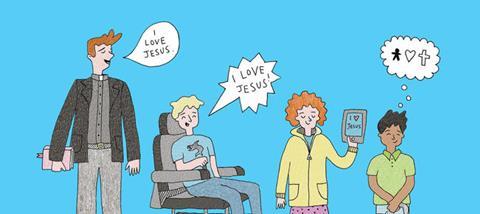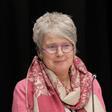Kay Morgan-Gurr explores spiritual development in young people with additional needs

Last year, I had someone quietly sit next to me and whisper a question that really shocked me: “Is it really possible for those who have learning disabilities to become Christians?” The subtext was: “If they can’t tell me what makes them Christian to the level I expect, how can they be?” My answer was remarkably restrained, especially knowing that I can get very cross when faced with such ideas: “Yes they can, but often no thanks to a church that doesn’t see the need to teach these children and young people in a way they can access.”
I often speak on this subject, making the point that when the Holy Spirit is at work we don’t have the automatic right to understand or know what he is doing. Here’s the shocker: the Spirit doesn’t always need our help either. A child or young person doesn’t have to explain their faith with five points of clear theology. Their God is just as powerful as ours, and he speaks to them in a way they can understand and respond to. Their worship is a sweet aroma, cherished by God. Sometimes the depth of their faith can only be “Jesus loves me, this I know”, and God loves it and them. Thank goodness, and God, for that.
You don’t have to have an additional need or disability to face the “Can they be Christians?” question, but it is an issue that many of our children who happen to have disabilities and additional needs face all the time. And so do their families. Those of us leading and ministering in the Church – including children’s, youth and families’ work – are more than aware that part of our remit is helping to grow enduring faith in the lives of those we are responsible for. We do this by supporting families, working through the wider church family and operating within age-appropriate groups. For some reason when we think of young people with additional needs and disabilities we go as far as physical and sensory inclusion, but we sometimes fall short when it comes to spiritual inclusion.
We also put the ‘additional needs’ children into a single silo where one size fits all, and it doesn’t work. In fact, this method tends to favour one specialism and forget the rest. If our starting point is to think of two silos – for want of better words: those with additional needs or disabilities and those without – we will inevitably forget one of those silos. Not deliberately, but because our thinking often prioritises physical and emotional access ahead of spiritual development. Our starting point needs to be looking at all our children and then asking: how can I remove the obstacles in the way of how some of them will learn, and instead put in place things that will boost access and understanding?
As part of my role with Children Matter, I have been looking at lifelong, resilient faith formation for young people in every sphere of life. We have built on the Australian Here2Stay research and found that there are at least five areas that help to build this resilient faith. In looking at these areas we can see that there is no difference for those who have additional needs and disabilities.
Community
The first of these areas is community: helping the Church to thrive as a growing, intergenerational faith community while supporting the family as a key place of spiritual nurture. The Bible tells us in various places how important community is to all of us. Hebrews 10:24-25 (NIrV) says: “Let us consider how we can stir up one another to love. Let us help one another to do good works. Let us not give up meeting together. Some are in the habit of doing this. Instead, let us cheer each other up with words of hope.”
When we consider that many children with additional needs have been forced out of the Church and their families have effectively been ostracised, this passage takes on an extra dimension. Where and how do these young people find community when the Church is out of bounds?
Rachel had one child on the autistic spectrum and a child with specific medical needs requiring many stays in hospital. She had been turned away from the church she grew up in, having been told to “find a church more appropriate to her needs”. She found her new church by searching the internet for one that mentioned access on their website. She met with the children’s leaders to talk about her children, but in doing that found many others in the church started to do small things to help them as a family. Some sat alongside them on a Sunday and assured her that noise and movement was not a problem in services, and they took time to build trust with both her children. Sometimes there would be a postcard through the door saying “We’re praying”. Sometimes a casserole would magically appear on the days her child had a hospital appointment.
Encounter
The next area is encounter: creating opportunities for children to connect with the big story of the Bible and making space for them to encounter the living Jesus for themselves. As youth, children’s and families’ workers this is another part of what we do. We get the importance of this. Most of us also see the difficulties some of our young people face in this area. There are no resources for many because most producers of resources tend to go for a one-size-fits-all strategy (which is more financially viable). For those who do consider additional needs in their publications, we generally get another layer of one size fits all. Many think that repurposing material for younger children with older young people is fine if they have additional needs, when actually it is just patronising for many. Disability or not, they are still the age they are.
But what about those with physical disabilities? A lot of the discussion around additional needs at the moment covers social, sensory and learning difficulties. We forget that we have children with sight loss, hearing loss and mobility difficulties. There are precious few resources for young people with sight problems and other reading difficulties. Where can they find resources that encourage an ongoing encounter with Jesus? It’s even harder if you are between the ages of 9 and 16, as most of the specialist material is aimed at the younger and older ends of our work.
Harry loves colour. He talks to God using colours and he says that God talks back to him in colours too. When he doesn’t know what to say or how to express his feelings in ‘real words’, he knows God understands his colour language.
Dialogue
Dialogue is another area we consider: encouraging faith to be both talked about and lived out within peer relationships, supported by mentors and the wider church family. It’s good to talk, and when we use the word ‘dialogue’ we naturally think of the verbal version of talking. But there are many forms of communication: signing, using symbols, written communication, facial expressions, actions and even behaviour. I’ve worked with young people with cerebral palsy who ‘nose spell’, using their noses to spell out words in the air. For me as a dyslexic, trying to decipher and put together letters that were back to front made for some hilarious (and very long) conversations! But it was worth it.
Some of the questions I was asked using this method would challenge even the most qualified theologians. But my young friends felt listened to, and many became Christ-followers. Sadly, they were let down big time by their churches and slowly walked or rolled away from the Church, just because people couldn’t understand that ‘non-verbal’ didn’t equate to ‘non-Christian’. There were no peer relationships with other young Christians on offer and there was no suitable mentoring in place.
Some young people are non-verbal because the stress of speaking is too much. Also known as being selective mute, this part of the autistic spectrum is not understood well. But it shouldn’t be a barrier to the dialogue needed to support faith. For those who need it, let’s find new and imaginative ways to support this vital part of faith formation.
Belinda has cerebral palsy and a whole load of questions about God. She used an electronic talker to communicate her questions using her thumb knuckle to type. Over a coffee slurped through a straw, her youth worker spent a lot of time going through each of Belinda’s questions. She appreciated being spoken to like the 15-year-old she is.
Milestones
Milestones in our children’s lives are also big things: enabling peak experiences and celebrating key moments or anchor points in their lives and spiritual journeys. You can probably recall those moments when God felt extra close, or when you understood more about God. I’ve had a few of those. For many children and young people those moments occur on residential camps and at festivals, but for a significant number these events are not accessible. There are still organisers who turn those with additional needs away because “it might affect the enjoyment of others”.
For some, that defining moment comes at a special activity put on at their church, where they feel safe and understood. Then there are those anchor points that are familiar to all of us, such as baptism, confirmation or moving up to the next group. These things can be celebrated by the whole community, possibly videoed or being given a certificate to mark the day.
One member of the Additional Needs Alliance community tells of a young person who had grown up going to his additional needs group. He later opted to go to the church’s Alpha group, which she supported him through. He is now preparing to be baptised. She says: “Some of his understanding is a bit mixed up, but when I asked him questions in order to help him write his testimony, he was very clear about knowing that God loves him, that Jesus died for him and forgives his sins, and that the Holy Spirit gives him power both to make good choices in his life and to help him battle temptation. Because of his needs, he would have found it very difficult to be part of the young people’s groups, and I don’t think he would have got to this stage of faith if the option of our group wasn’t there for him.” This shows a whole mix of things that have helped to develop faith, with each area of faith formation underpinning another, culminating in a key moment in this young man’s faith journey: baptism. This is a great example of the different areas of faith development in action.
Action
Another area remains – action: allowing children to contribute as active participants in mission and giving them the opportunity to respond with compassion to the world around them. This area continues to be one that is often neglected for children with additional needs. There are many reasons for this, including the historical view of disability being something we pity. Many people think of disabled people as recipients of our action rather than the source of action. I agree with the idea that our young people need the space to prayerfully decide where God would have them serve, with us being the facilitators. But we need to remember that when we are facilitating action for those with additional needs we may need to present the options, create the space to see and understand, and, where necessary, give a social story to support them in putting their faith into action. (A very simple explanation of a social story is a story that accurately describes a context, skill, achievement or concept for young people, usually those on the autistic spectrum. Do find out more from those who know how to write them.)
For me, as a predominantly non-verbal child until my early school years, I learnt a great deal by watching others. My mum baked and took pies to people who were ill, taking me along with her. She did their ironing and explained to me why she did so. As I grew and found my voice, I would independently go and visit older church members, all because someone showed me the way.
Rebecca struggles with severe ME. She wanted to “do something for God”, but knew how limited she was. She had found many other Christian teenagers with ME in social media groups. They came from all over the world. They now have a Skype prayer meeting every Thursday afternoon to pray for the world.
There is plenty of discussion about faith development in our young people, and how we support families as the key place for spiritual nurture. But for many families who have children with additional needs the struggle is greater and the resources are minimal. If you are the parent of a child with additional needs or a disability the struggle is even harder, as much of the material out there – with the occasional exception – is made for people who can physically read print. Young people with additional needs and disabilities have the right to be discipled in faith, to grow in the Spirit and to practically live out their faith. Please don’t forget them.
































